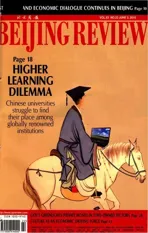Seeking Educational Excellence
2010-12-27ByYAOBIN
By YAO BIN
Seeking Educational Excellence
By YAO BIN
China’s higher education is strong, at least statistically. It already leads the world in terms of the number of universities and enrollment rate. In 2009, college graduates totaled 5.31 million, compared to 848,000 a decade ago. Despite this, even the most self-confdent Chinese teachers have to admit they still do not have their dreamed of world-class universities.
On the 2010 list of world’s top 100 universities issued by U.S. News and World Report, the highest-ranked Chinese university is Peking University in 52nd place, followed by Tsinghua University in 56th. Another research study by China’s Shanghai Jiaotong University has even disqualifed all of China’s higher learning institutions from entering a list of the world’s 500 best academically performing universities.
When and how does China go about establishing the world’s best seats of learning? People in and outside the education sector are looking for the answer. Comparatively, foreigners seem much more optimistic. Foreign participants attending the Fourth China-Foreign University Presidents Forum last month said the goal would be attainable in 20-50 years.
Solving problems deep in China’s higher education system is not just a matter of time, because China still lacks a modern system for running universities. Without this, the country is very likely to move further from, instead of nearer to, its goal of world-class universities no matter how hard it struggles in the next few decades.
Under China’s current higher education system, universities are heavily dependent on the government and practice bureaucratic management. The bureaucracy also turns professors into officials, who pursue higher positions instead of academic achievement.
The State Guidelines for the Medium- and Long-Term Educational Reform and Development Plan (2010-20), which were issued in February for public feedback, give priority to the removal of bureaucratic management in institutions of higher learning and increasing their autonomy, especially in academic affairs.
More importantly, there must be new and diversified criteria to assess the performance of universities of different sizes and resources, more than just the quantity of papers they produce.
Apparently, only when all Chinese universities fnd development roadmaps suitable for their own characteristics and build up their individual strengths, will they be able to catch up with the best in the world.
